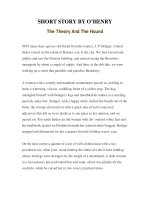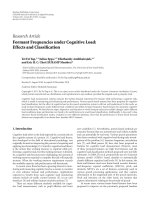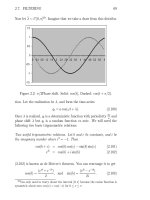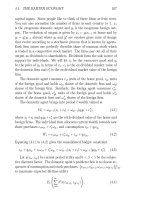Cognitive load theory and lesson planning
Bạn đang xem bản rút gọn của tài liệu. Xem và tải ngay bản đầy đủ của tài liệu tại đây (106.76 KB, 7 trang )
COGNITIVE LOAD THEORY AND LESSON PLANNING
(Vận dụng Lý thuyết Tải lượng tri nhận vào thiết kế bài giảng)
Abstract
Lesson planning may be a trouble to all teachers sometimes. The lesson plans may look good and
scientific, promising successful teaching sessions; however, in practice, they still fail to get
students learn the lessons and fail to encourage them take in new knowledge as expected. The
answer to this problem has lately been found and it is largely attributable to the architecture of
human cognition. For the past fifty years, there have been a good number of studies dwelling
deeply into the cognitive architecture as well as the cognitive process of humans. Those studies
have contributed to bringing us the knowledge about the components that shape human memory
and how human memory works. Findings about the human cognitive architecture are of great
importance to various areas, including the science of education. By looking into the human
cognitive architecture and the theory of cognitive load, this article presents a brief summary of
how to plan lessons in an effective manner by applying the cognitive load theory to lesson
planning.
(Việc thiết kế bài giảng, soạn giáo án đôi khi tạo nên một áp lực không nhỏ đối với đội ngũ giảng
dạy. Giáo án đôi lúc được thiết kế rất khoa học và hứa hẹn những giờ giảng tốt nhưng trên thực tế
lại không phải lúc nào cũng vậy và người học không đáp ứng được đòi hỏi tiếp nhận kiến thức
mới như mong đợi. Nhiều câu trả lời cho vấn đề này được đưa ra, trong đó có sự liên quan trực
tiếp giữa khối lượng kiến thức và cấu trúc tri nhận của người học. Về khoa học tri nhận, trong
năm mươi năm gần đây đã có nhiều nghiên cứu chuyên sâu tập trung bóc tách cấu trúc bộ nhớ
con người cũng như cơ chế hoạt động của nó. Kết quả từ những nghiên cứu này đã đóng góp một
phần quan trọng vào nghiên cứu phát triển nhiều lĩnh vực liên quan tới tư duy của con người,
trong đó có khoa học giáo dục. Bài viết này tóm lược cấu trúc tri nhận của con người và phân tích
Lý thuyết Tải lượng tri nhận (Cognitive Load Theory) cũng như ứng dụng lý thuyết này vào thiết
kết bài giảng với mục đích đem lại hiệu quả trong quá trình giảng dạy.
Keywords: cognitive load theory (lý thuyết tải lượng tri nhận), lesson planning (thiết kế bài
giảng), human cognitive architecture (cấu trúc tri nhận con người), human memory (bộ nhớ con
người)
Preparation of a lesson is much related to understanding of human cognitive architecture and how
its components work. A good lesson plan often utilizes positive features of the architecture and,
therefore, facilitates learning. This article seeks to summarize the architecture of human cognition
and the cognitive load theory and apply its education implications to making lesson plans.
Introduction to human cognitive architecture
Human beings stand out from other animals in that we know how to think. Thinking is the very
feature that leads to the desire to tirelessly discover new information and knowledge, including
the wish to find out where knowledge comes from, where it is stored, how it is later retrieved for
use and what the architecture of human cognition is like. Previously, for a very long period of
1
time, people used to think that human memory consists of just one single part. However, as
various experimental studies were conducted, scientists came to find out that human memory
consists of different equally-important components. According to Ayres (2010), human cognitive
architecture is broken down into three parts, namely the sensory memory, the working memory
and the long-term memory. The sensory memory takes in new information via visual and audio
channels. However, according to Atkinson & Shiffin (1968), the sensory memory is very limited
in capacity (just several millionth of a second) and new information entering the sensory memory
decays quickly. New information goes through the sensory memory via the two channels then
reaches the working memory. In fact, the working memory is where learning occurs, as it is the
place where the human cognitive process takes place, helping humans understand and control the
information stored there. Therefore, the working memory itself is more complicated than the
other two components. It also has three parts, namely the audio patch (capable of keeping
information there for two seconds), the image and spatial sketch (keeping and processing
images), and the central processing unit which controls the whole system of analyzing
information stored in the working memory. New information often enters the working memory in
the forms of sounds or images or both. Like the sensory memory, the working memory is also
limited in capacity. Miller (1956) proves that depending on individuals, the working memory is
capable of storing 7+/-2 units of information at the same time. It would be difficult for a person to
remember if the units of information exceed that magical number (7+/-2) and without assistance.
A very common example is memorizing telephone numbers. For a ten-digit number like
0975468312, if a person takes in the formation in the way that breaks down the number into the
ten separate digits like 0-9-7-5-4-6-8-3-1-2, he/she will most likely fail to keep the number in
his/her mind after just a few seconds. However, if the person breaks the number into three chunks
like 0975-468-312, he will likely remember the number for much longer. That is because the
chunking turns the number into three units of information instead of 10 units like before, which is
within the capacity of the working memory. Looping or continuous repetition and concentration
are important to keep the information in the working memory from decaying. Otherwise, the
information will decay quickly, leaving space in the working memory for newer information
entering via the sensory memory (Sweller, 1999).
The information when received and placed into the working memory will be processed. However,
information in the working memory comes not only from the sensory memory, but also from the
long-term memory. Therefore, in the working memory, new information will interact with
available information retrieved from the long-term memory. The combined information,
including both new information from the sensory memory and available information from the
long-term memory, will eventually be stored in the long-term memory in the form of schemas.
Those schemas can be simple or complex; however, each of them is all about related contents.
Regardless of being simple or complex, each schema is treated equally by the memory as one
unit of information. When stored in the long-term memory, the information will remain there
forever. However, unlike the previous two memory components, the long-term memory is
controlled by sub-consciousness and the information from the long-term memory is only
managed by consciousness when it is accessed and retrieved by the working memory, which is
very small in size. Therefore, the retrieval of information from the long-term memory must be
triggered by information received externally through the sensory memory and the working
memory. Another point is that when new information is stored in the long-term memory, if it is
not linked to (one) available schema network(s), it will be very difficult to be retrieved for future
use.
2
Cognitive Load Theory
While cognitive psychologists mainly focused their studies on the human cognitive architecture
(including the structure of the working memory), Professor John Sweller focuses his research just
on the working memory and devises the Cognitive Load Theory. However, the research of John
Sweller and his colleagues around the world does not focus on the structure of the working
memory itself, which has been thoroughly analyzed by Baddeley (1992), either. For 25 years,
Sweller and his team of scientists from different countries have concentrated on determining how
the processing of information affects the working memory and the load of different specific tasks
imposes on this very limited-in-capacity memory. The findings show that depending on the
difficulty of the tasks, the cognitive load imposed on the working memory varies and brings
different information processing results. Sweller then came to propose three different types of
cognitive load: intrinsic load, germane load, and extraneous load. Like many other studies and
theories on human cognitive architecture, the cognitive load theory aims to find out what hinders
and what facilitates learning to make adjustments for learning to take place in the most effective
fashion.
Of the three types of cognitive load imposed on the working memory, not all facilitates learning.
Therefore, the point is to minimize the load that obstructs learning and increases the load that
supports learning. As mentioned, the three types of load imposed on the working memory are
intrinsic load, germane load, and extraneous load. The intrinsic load is caused by the level of
difficulty of the task imposed on the working memory. This load is not adjustable in that it
depends on the task; therefore, as soon as receiving a task, part of the working memory is
immediately consumed. However, adjusting the level of difficulty of the task (a lesson in the case
of teaching), making it easier to follow with appropriate steps in the teaching process, will result
in smaller intrinsic load, and in turn create the germane load on the working memory. At the other
extreme, extraneous load will be created in the working memory when the person has to process
information irrelevant to the content of the task (in case of learning, the learner has to deal with
redundant and unsuitable information in the lesson). In that case, the working memory is
consumed excessively by irrelevant information, affecting information processing, turning out
learning results that do not live up to expectation. For learning to best occur, it is essential to
maximize the germane cognitive load and minimize the extraneous cognitive load. This can be
done by designing lessons with appropriate levels of difficulty, reducing irrelevant information in
the lessons, creating less learning pressure on learners, etc.
It can be seen that how learners take in new knowledge is related directly to the human cognitive
architecture in general and types of cognitive load in particular. Understanding the cognitive
architecture and cognitive loads imposed on the working memory, teachers can design lessons in
a way learners can receive new information/knowledge more easily and effectively and
remember it longer.
Educational implications
First, as the working memory can only work effectively when storing 7+/-2 units of information,
if a lesson plan requires learners to process too many units of information at the same time, it will
surely fails to make learning occur (Sweller, 1994). When planning a lesson, teachers need to
choose contents with sufficient information for each period (not to exceed 7 units of information
to be processed at the same time). One of the important points is that emotions like anxiety or
fear are also considered units of information (irrelevant information). Therefore, teachers should
3
avoid making learners anxious and create no fears for them during the lesson to avoid creating
extraneous cognitive load in the working memory of learners.
Second, teachers need to design lessons in a way that the units of information are related to one
another so that they create a new schema in the working memory before being stored in the longterm memory of the learners. A well-designed lesson not only requires a reasonable number of
units of information, but also should have those units of information designed interrelated,
helping learning occur more easily.
Third, from the fact that learners only take in new contents when they focus their attention, new
contents to be taught should not be insufficient, too easy, nor too difficult. That is because
learners may easily lose their attention not only in case the contents are difficult, but also in case
the contents are too easy or boring. In both cases, learning does not occur and learners fail to
acquire the designated knowledge.
Fourth, as new information can only be stored in the long-term memory and retrieved most easily
later when the information has been integrated with available schema networks in memory. Thus,
in order for learners to master and be able to use the new knowledge with ease, the contents of
the lessons should be linked to practical experiences or introduced with information that learners
already know. For example, when teaching the content of How to make phone calls in English,
teachers should design the teaching content in a way that it elicits learners little by little so that
they can retrieve their available schemas related to this content from their long-term memory.
Questions like What is the make of the cellphone that you use? How often do you make phone
calls? Who do you often call? What are the steps in making a phone call?, etc. or practicing roleplay among learners in the classroom may be used. Those techniques trigger the information
(schemas) available in learners’ long-term memory. When new information is introduced
(grammatical content, for example), learners connect the new information into the available
information that they have retrieved to answer previous questions. The new information is now
processed and integrated into existing schemas before being encoded and stored back in the longterm memory. That is when learning really occurs and learners really acquire new knowledge.
Fifth, when new information is encoded and stored in the long-term memory, retrieval of that new
information to the working memory helps learners to remember the information better. To make
the most of this feature and help more learning occur, at the end of each lesson, before shifting to
new contents, teachers should design some activities to review and reinforce the learned contents.
This can be done in a number of ways, including listening to songs, requiring learners to write
assignments about the learned topics, and more. However, one of the most popular ways is
repetition. Repetition when conducted regularly will lead to automation, in which learners do
things (making phone calls in English in this case) at ease, without having to pay much attention
to the things, reducing the load imposed on the working memory.
Below is simple sample lesson plan for teaching the content “Making phone calls” and the
interpretation of cognitive process in accordance with the cognitive load theory.
4
Lesson plan and interpretation of cognitive process
Teacher: …/…/…
Class: …/
Date: …/…/…
Unit: …/.
ESL Standard: …/.
Lesson topic: How to make phone calls
Content Standard: …/.
Lesson aim: to enable students to make phone calls in
English fluently with steps and in different situations
Key concepts and Content: smartphone, caller ID,
contact(s), busy, greetings when making phone calls,
conversation development, parts of a telephone in general
and a smartphone in particular
Learning outcomes: At the end of the lesson, learners will
be able to follow steps to make a phone call and make
different phone calls to different people and places.
Strategies: Using materials and activities with consideration
of cognitive architecture and cognitive load in a way that
facilitates learning
Materials: board, markers, handouts, cellphone
Evidence of learning: Learners are able to make phone
calls in English with ease and with fun.
Steps
Activities
Cognitive process
Warm up
1
Teacher tells a joke about a conversation via the
telephone at a hotel and then asks several
questions to lead to the topic.
Model joke:
One morning, the receptionist at the front desk
of a hotel received a phone call from Room 223.
He picked up the receiver, said:
- Hello, how can I help you?
From the other end of the line, there was only
some sounds:
5
Warm up activities should
arouse learners’ attention and
connect the lesson contents to
learners’ learnt knowledge,
skills, experiences (schemas).
One important thing that warm
up activities benefit learners is
that it helps learners feel at
ease, thus removing anxiety or
fear of learning (acting as
extraneous load and occupying
part of the working memory)
- /Too tees too too too tee…/
Not quite understanding, the receptionist asked:
- Sorry, would you mind speaking again?
The person repeated and the receptionist again
heard the sounds:
- /Too tees too too too tee…/
Still unable to make out what the caller meant,
he rushed to Room 223 and learnt that the
people in that room wanted to order “2 teas to
(room) 223.”
Instruction (mini-lesson)
2
- The teacher hands out a telephone
conversation model to learners and note
important sentences (greetings, introducing
names, asking for information of callers, etc.).
- The teacher uses his/her cellphone to
introduce parts of the telephone to learners.
- Learners are to note down the vocabulary and
structures.
- The teacher calls two learners to play the roles
of caller and receiver and let them read out loud
the conversation model.
In this part, the teacher
introduces the contents of the
lesson with connection with the
information that he/she triggers
learners to retrieve to the
working memory during the
warm up part. Now, learners’
attention has been focused on
the topic of the lesson, they may
learn better. The teacher is to
keep them excited about the
contents by using activities that
require learners to engage in or
directly conduct mock-up phone
calls that look like real.
Now, it is important that the
teacher does not give input of
too much information for
learners. Otherwise, the teacher
may create a huge intrinsic
cognitive load, occupying much
of the working memory, resulting
in little learning. The teacher
may need to break this part into
the “Grammar,” “Structure,” and
“Vocabulary” contents.
Practice
3
- Role play (teacher - learner): The teacher uses
his/her cellphone, asks for a learner’s number
and makes a direct phone call to the learner. At
this time, the conversation model is used for the
role-play.
- Role play (learner – learner): The teacher asks
the learners to set pairs. If the number of
learners is odd, the teacher will join the activity.
6
This is the part that the teacher
helps learners process the new
information (grammar,
vocabulary, structures…) and
integrate that information into
existing schemas (how to use
smartphone, how to dial a
number, how to answer a phone
call, etc.) in learners’ long-term
Then, he/she asks the pairs to move their chairs
so that the pairs sit back-to-back (making sure
that they don’t see each other’s face). The
learners are now to make phone calls, using the
conversation model. After some time, the
teacher set themes for the pairs to practice (call
to the airport, hospital, hotel, etc.).
memory.
Follow-up Activities/ Independent practice
For more learning to occur, the
teacher is to help learners
retrieve the newly-learnt
information by giving them
chance to use the information.
This can be done by different
activities like asking questions,
telling stories, etc.
4
- Tell a story about a special phone call that a
learner once made (calling the wrong number,
for example).
5
Homework: Learners learn by heart words
related to telephone and phone calls.
Automation (repeat and repeat
and repeat) to consolidate the
newly-learnt information
6
Reflection: (If possible) learners are to make a
phone call each to the teacher when they get
home that day.
For more learning to occur
(retrieval of the newly-learnt
information)
Conclusion
As the human cognitive architecture has been carefully studied and proven to be limited in
capacity and the working memory, where learning occurs, can be imposed with extraneous
cognitive load that hinders learning effectiveness, designing lessons could be a problem to any
teachers if without taking into account these features. On the other hand, fully grasping these
cognitive features may help teachers develop their suitable teaching styles and plan their lessons
in a way that best facilitate learning.
REFERENCES
Atkinson, R. C., & Shiffin, R. M. (1968). Human Memory: A proposed system and its control
processes. The Psychology of Learning and Motivation, 2. New York: Academic Press.
Baddeley, A. (1992). Working Memory. Science, 255(5044), 556-559.
Ayres, P. (2010). Human Cognitive Architecture, Lecture notes. University of New South Wales.
Miller, G. A. (1956). The Magical Number Seven, Plus or Minus Two: Some Limits on Our
Capacity for Processing Information. Psychology Review, 63, 81-97.
Sweller, J. (1994). Cognitive Load Theory, Learning Difficulty, And Instructional Design.
Learning and Instruction, 4, 293-312, Pergamon Press.
Sweller, J. (1999). Instructional Design in Technical Areas. Melbourne: ACER Press.
7









